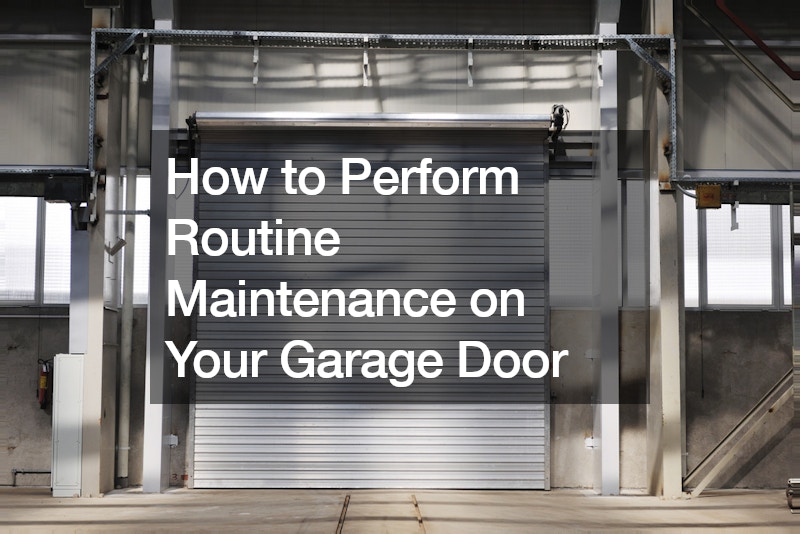
Garage doors are an essential part of our homes, providing security and convenience. However, like any mechanical system, they require regular maintenance to ensure they operate smoothly and last for many years. Regular maintenance can prevent costly garage door repair and extend the life of your door. In this guide, we will walk you through the steps of performing routine maintenance on your garage door, saving you both time and money.
Introduction to Garage Door Maintenance
Routine maintenance on your garage door is crucial. It helps in preventing unexpected malfunctions and costly garage door repairs. Most maintenance tasks are simple and can be done in about 15 minutes. This article will cover the basics of garage door maintenance, including tightening hinges, lubricating moving parts, and checking the door balance.
Tools Needed for Garage Door Maintenance
Before you begin, gather the following tools:
– A wrench or socket set
– Lubricant (such as Pro 44 multi-purpose lubricant)
– Scrap cardboard
These tools are essential for performing the maintenance tasks effectively.
Step-by-Step Maintenance Guide
1. Preparing for Maintenance
The first step is to disconnect the garage door from the opener. This allows you to manually operate the door and ensures your safety while performing maintenance.
2. Checking and Tightening Hinges
Hinges are crucial components that ensure the smooth operation of your garage door. Over time, they can become loose. Using a wrench or socket, check each hinge to ensure it is tight. You don’t need to apply excessive force; just make sure they are secure. If a hinge is loose, tighten it carefully. Properly secured hinges reduce noise and ensure the door operates smoothly.
3. Lubricating Moving Parts
Lubrication is vital for the longevity and smooth operation of your garage door. Focus on the following areas:
Hinges: Lubricate both the inside and outside of the hinges. This helps them move freely and reduces wear and tear.
Roller Pins: Lubricate the roller pins on both sides. Spin the rollers to ensure the lubricant spreads evenly.
Roller Bearings: If your door has metal rollers with ball bearings, lubricate these as well. However, many modern doors have nylon rollers without bearings. You can still lubricate the pin to enhance movement.
I highly recommend upgrading to sealed bearing nylon rollers. They are quieter, smoother, and more durable. Replacing your rollers with these can significantly improve the operation of your door.
4. Lubricating the Springs
Garage door springs are under high tension and help in lifting the door. Lubricating them is crucial. Use a piece of scrap cardboard to shield surrounding surfaces from the lubricant. Apply the lubricant liberally to the springs. This reduces friction and prevents rust, ensuring the springs last longer.
5. Lubricating the Pulleys and Cables
Pulleys and cables are integral parts of the garage door system. Apply lubricant around the pulleys where the cables run. You can also lightly lubricate the tension cables to reduce friction and extend their lifespan. Ensure you also lubricate the bearings on the pulleys. This is crucial for smooth operation.
6. Lubricating the Rail
The rail is the track that the door’s traveler moves along. Lubricate the top part of the rail where the traveler contacts it. This part usually gets dry and can cause noise or friction. Run the lubricant along the length of the track on both sides to ensure smooth movement.
7. Testing the Door Balance
After lubricating all the parts, test the door balance. Manually lift the door to the halfway point and let go. The door should stay in place. If it doesn’t, the springs might need adjustment. Balancing the door is important for its longevity and functionality. If the door is unbalanced, it can cause undue strain on the opener and other components.
Adjusting springs can be dangerous. If you are not comfortable doing it yourself, consider hiring a professional for this task.
8. Checking the Door Seal
While the door is open, inspect the seal at the bottom. Look for any rips or tears. A damaged seal can allow water, debris, and pests into your garage. Replacing the seal is easy and ensures your garage remains insulated and clean.
Benefits of Routine Maintenance
Performing regular maintenance on your garage door offers several benefits:
Saves Money: Regular maintenance can prevent major issues that require costly garage door repairs.
Extends Door Life: Proper care and lubrication reduce wear and tear, extending the life of your garage door.
Ensures Smooth Operation: A well-maintained door operates smoothly and quietly.
Enhances Safety: Regular checks and adjustments ensure all parts are functioning correctly, reducing the risk of accidents.
Conclusion
Performing routine maintenance on your garage door is a simple and cost-effective way to ensure its longevity and smooth operation. By following this guide, you can keep your garage door in top shape and avoid the need for expensive garage door repairs. Remember to check and tighten hinges, lubricate moving parts, test the door balance, and inspect the door seal regularly. These steps will help you maintain a safe, efficient, and long-lasting garage door.
Regular maintenance not only saves you money but also gives you peace of mind knowing that your garage door is functioning properly. So, take the time to perform these simple tasks, and your garage door will thank you with years of reliable service.
.

